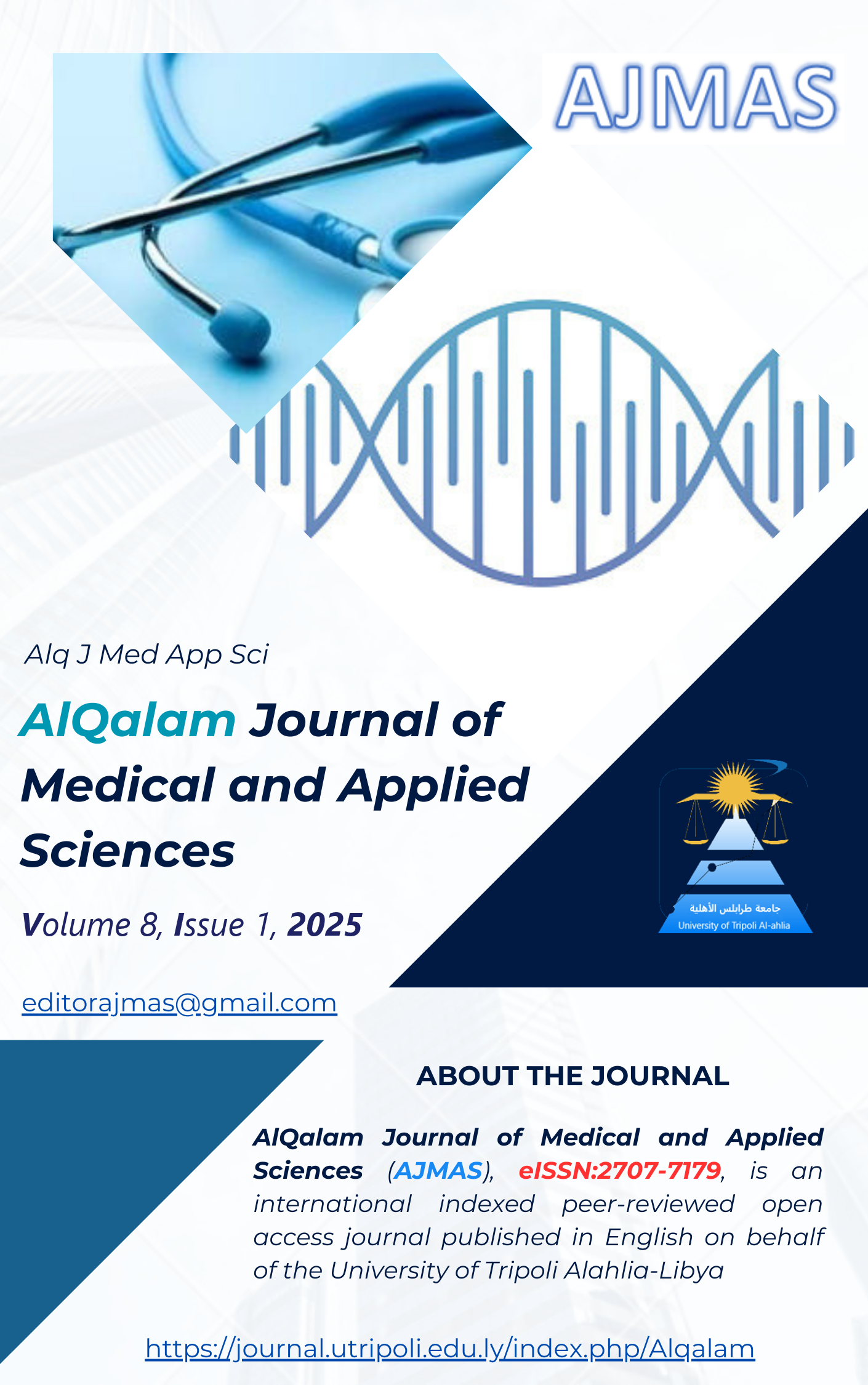Radiographic Assessment of the Quality of Root Canal Fillings Performed by undergraduate Dental Students in Tripoli, Libya: A Pilot Study
DOI:
https://doi.org/10.54361/ajmas.258148Keywords:
Endodontic Treatment, Undergraduate, Radiographically, Criteria.Abstract
The success of endodontic treatment is remarkably affected by the radiographic technical quality of the canal(s) filling. The pilot study aimed to assess the root canal fillings performed by fourth-year students at the College of Dentistry, University of Tripoli, Libya, during the 2024 academic year. Undergraduate preclinical dental students performed a root canal treatment on 73 single-rooted artificial teeth. For root canal preparation, the step-back method was used with hand-held instruments made of stainless-steel files with a 0.02 taper and up to the master apical file 30. Normal saline solution was then used for irrigation. The cold lateral condensation method was used to fill each root canal. After that, the teeth were gathered and radiographically assessed using three quality criteria (length, density, and taper). Descriptive statistics, including frequencies and percentages, were used to summarize the data. The study's findings showed that the general caliber of root canal fillings was poor. Nonetheless, almost 50% of the research sample (63%) had adequate length, 40% had adequate density, and 43% had adequate taper. In the case of Taper, nearly half of the cases (49%) were rated as very insufficient. Overall, the performance of male and female dental students in root canal filling was comparable, with no statistically significant differences observed in length, density, or taper. The assessment of dental students' performance in root canal filling reveals a foundational understanding of essential clinical skills, alongside identifiable areas for improvement. The comparison between male and female students showed no statistically significant differences in performance in root canal filling, suggesting that both groups are equally positioned in their clinical training.
يتأثر نجاح العلاج اللبي بشكل ملحوظ بالجودة الفنية الشعاعية لحشوة القناة (القنوات). هدفت الدراسة التجريبية إلى تقييم حشوات قناة الجذر التي أجراها طلاب السنة الرابعة في كلية طب الأسنان، جامعة طرابلس، ليبيا، خلال العام الدراسي 2024. أجرى طلاب طب الأسنان ما قبل السريري الجامعي علاج قناة الجذر على 73 سنًا اصطناعيًا أحادي الجذر. لتحضير قناة الجذر، تم استخدام طريقة التراجع مع أدوات يدوية مصنوعة من ملفات من الفولاذ المقاوم للصدأ بتدوير 0.02 وصولا للملف القمي الرئيسي 30. ثم تم استخدام محلول ملحي عادي للري. تم حشو جميع قنوات الجذر باستخدام تقنية التكثيف الجانبي البارد. ثم تم جمع الأسنان وتقييمها شعاعيًا بناءً على ثلاثة معايير للجودة (الطول والكثافة والتدريج). تم استخدام الإحصائيات الوصفية، بما في ذلك الترددات والنسب المئوية، لتلخيص البيانات. كشفت نتائج الدراسة أن الجودة العامة لحشوات قناة الجذر كانت رديئة. ومع ذلك، كان لدى أكثر من نصف عينة الدراسة (63%) طول كافٍ، وكان لدى 40% كثافة كافية، وكان لدى 43% تدريج كافٍ. وفي حالة التدريج، تم تصنيف ما يقرب من نصف الحالات (49%) على أنها غير كافية للغاية. بشكل عام، كان أداء طلاب طب الأسنان الذكور والإناث في حشو قناة الجذر قابلاً للمقارنة، مع عدم ملاحظة أي فروق ذات دلالة إحصائية في الطول أو الكثافة أو التدريج. يكشف تقييم أداء طلاب طب الأسنان في حشو قناة الجذر عن فهم أساسي للمهارات السريرية الأساسية، إلى جانب مجالات يمكن تحديدها للتحسين. أظهرت المقارنة بين الطلاب الذكور والإناث عدم وجود فروق ذات دلالة إحصائية في الأداء في حشو قناة الجذر، مما يشير إلى أن كلتا المجموعتين في وضع متساوٍ في تدريبهما السريري
Downloads
Published
How to Cite
Issue
Section
License
Copyright (c) 2025 Sumaya Aghila, Mohamed Hshad, Mohamed Issa

This work is licensed under a Creative Commons Attribution 4.0 International License.














